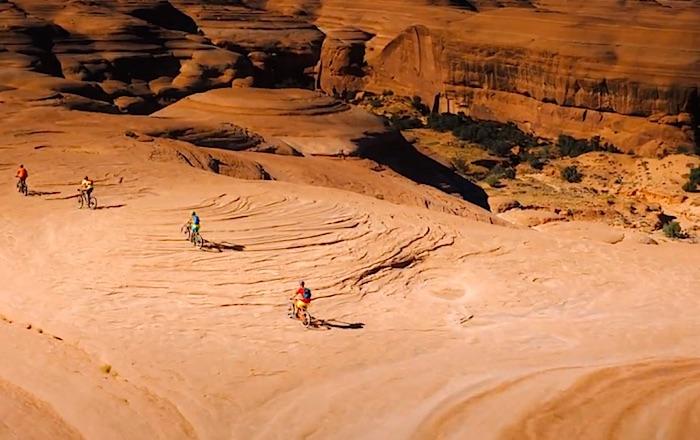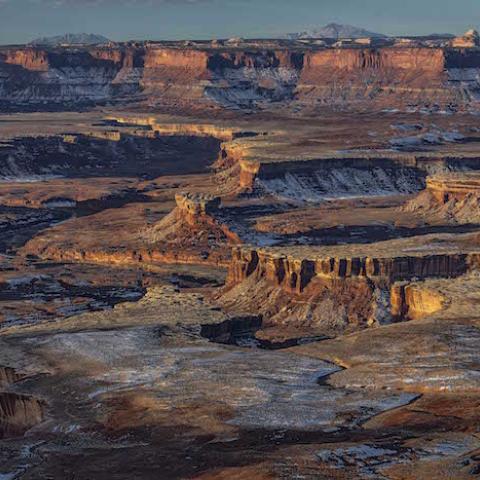
This image taken from the trailer for the film National Park Adventures might be inferred by some to mean off-trail mountain biking is permitted in national parks, which it is not.
America's national parks will be gorgeously portrayed in an IMAX® production coming to theaters next year, but the trailer could be construed as misleading in that it shows mountain bikers cavorting in a red-rock landscape that is not located within a park. Indeed, the activity as portrayed is actually banned in national parks.
Certainly, the National Park Service's centennial next year is drawing amazing amounts of attention, and visitation to the parks this year. But some park managers are wondering why the producers of National Parks Adventure had to drop the adrenalin-pumping mountain bike sequence into their promotions, their trailer...and most likely their movie.
"When that group was here filming, we told them very clearly, because we were aware that they were filming bicycling on (U.S. Bureau of Land Management Land) land, that that activity was not allowed in Canyonlands and we were adamant that it not be shown in a way that might suggest it was legal in the park," Kate Cannon, superintendent of Canyonlands and Arches national parks, said Thursday. “I just find it disingenuous to show that activity in a film that purports, I believe, to be about national parks. I think what that’s doing is trying to sell the film with that dramatic footage, which I found peculiar."
Here's a segment taken from a promotion of the film earlier this year:
On Thursday a trailer for the film was promoted on social media channels by USAToday. It ended with an aerial view of mountain bikers.
Superintendent Cannon was frustrated by inclusion of mountain biking in the trailer, because riding off-trail in the parks is not permitted and this footage might encourage some riders to seek it out.
“It’s a real frustration," she said. "I think what we have to do is redouble our effort on our own social media and all of our information to our visitors to make it clear up-front that mountain biking is allowed in parks, but only on the same roads that vehicles are allowed to go on, and we’ll be doing that.”

Though a stunning image, this type of off-trail mountain biking is not allowed in national parks yet appears in a film promoting national parks.
After USAToday promoted the trailer on its social media channels, the National Park Service's social media team in Washington, D.C., retweeted USAToday's tweet to its nearly 200,000 followers.
Park Service officials in Washington said the film is to make it clear that the mountain biking segments were not filmed in a national park.
"The National Park Service worked with the producers to provide the necessary permits for the film project and offered recommendations and input on the film's content. The final decision about what footage was included in the film was made by the producers," the agency's chief spokesperson, April Slayton, said in an email Thursday. "The National Park Service strongly recommended to the producers that they clearly indicate that the mountain biking featured in the film was not filmed in a national park."
During inquiries to the producer's public relations firm last month, the Traveler was told that, "the film narration specifically says that our characters are outside a park. The film makes it very clear that this activity is not happening inside a national park."
The trailer, however, does not.




 Support Essential Coverage of Essential Places
Support Essential Coverage of Essential Places







Comments
Kurt, have you talked with senior NPS employees about what they think about the agency's demographic future? This is not a rhetorical question but a sincere one. I'd be interested to get their perspective, if you have talked with them and ascertained it. Thanks.
Haven't had any conversations lately, or seen any terribly recent studies. Here's what I have seen:
"Only about one in five visitors to a national park site is nonwhite, according to a 2011 University of Wyoming report commissioned by the Park Service, and only about 1 in 10 is Hispanic" -- from a NYTimes story in 2011.
Then there was this from the NPCA's Second Century Commission report:
But let's get back to relevancy. How relevant is Fort Laramie National Historic Site to Asians or Hispanics? Yellowstone is world-famous for its thermal features, and lures huge Asian audiences. So does the Grand Canyon. Can you ever make Fort Laramie "relevant" to large Asian populations? I doubt it.
Golden Gate NRA is in a large metropolitan area. Does it lack for diversity, either racial or age? I don't think so. Ditto for Gateway NRA in the greater New York-New Jersey metropolitan area.
My guess is you could have cross-park mountain biking at places such as Fort Laramie, Tallgrass Prairie, and Cape Lookout National Seashore and it wouldn't affect the relevancy of those places or the diversity.
Is Machu Picchu an incredible tourist draw because you can mountain bike there, or because of its history as an Incan citadel and its location?
Can it be we look too hard at statistics to settle on how "relevant" units in the National Park System are? I don't think their worth or value should be measured by how much money they generate as "economic engines" or how many different generations and different races they attract.
The idea behind the national park movement was to set aside incredible places for future generations...not to set them aside for only as long as they appear "relevant" as measured by dollars generated or visitor diversity or recreational outlet.
I see that the HOHA mentality is still strong with the NPS and this site. I wonder when either will catch up the 21st century.
That seems odd. A third of all national park visitors are Native Americans and another 11% Hawai'ians and Pacific Islanders?
I see long queues of RVs and rental cars outside parks like Arches and similar vehicles in the settlements that spring up alongside the more popular parks. I sense they're filled mostly with Caucasian retirees and families with middle-aged Caucasian parents. But maybe I'm stereotyping; after all, Justice Clarence Thomas tours the national parks in summer in an RV. Still, when on occasion I'm actually in a national park, on foot, I mostly see elderly Caucasians in parking lots and younger ones on the trails. I don't see many people from other ethnic groups. But I admit that the plural of anecdote is not data.
While I personally wouldn't be opposed to limited mountain biking in the parks I have a difficult time understanding why people think that just because they want something everyone else has to cater to them. Where do you draw the line or is there no line? Should we open everything up to atvs,, offroad trucks, snowmobiles, off road motorcycles, drones, base jumping, paragliders, skateboarders, motorboats etc. My point is there has to be lines drawn and the parks should in my opinion strive to give people an appreciation for the outdoors and I'd like to say wilderness experience but that (unfortunately) has gone out the window in most of our parks long ago. There are plenty of places to mountain bike, ride snowmobiles, fly without demanding that the parks also be open to that. I also don't think banning mountain biking is going to have any negative impact on the future of our parks. The biggest negative is the over crowding which has come from adding too many creature comforts, miles of paved roads, cafeterias, parking lots, hot showers etc..... Yes, I enjoy some of these activities and amenities too but trying to please more people has in my selfish opinion ruined the things I used to love most about our parks. Return them to a place for hiking, backpacking, camping, picnicking, and getting AWAY from the crowds.
Exactly right, Wild.
It's just the Great American Entitlement Mentality on full display.
Lee, are you unable to articulate a full argument? :)
The whole thing is silly. The NPS claims to preserve the parks for future generation yet allows horses to trample trails. What a joke! We were in Bryce over the summer and I noted that there was a trail reserved for horses. Nice!
The "where you draw the line" argument shows a clear lack of understanding of the issues and has been debunked many times.
Zeb, the Entitlement Mentality rears its ugly head in virtually every aspect of life in our nation. Hikers are entitled. Horses are entitled. Bike riders are entitled. Rafters and kayakers are entitled. Drone flyers are entitled. The list is endless and not restricted only to parks. Everyone is entitled to anything they desire and we just dare anyone to suggest that there might be any limits placed on our desires.
And for goodness sakes, don't ask any of us to pay for it!